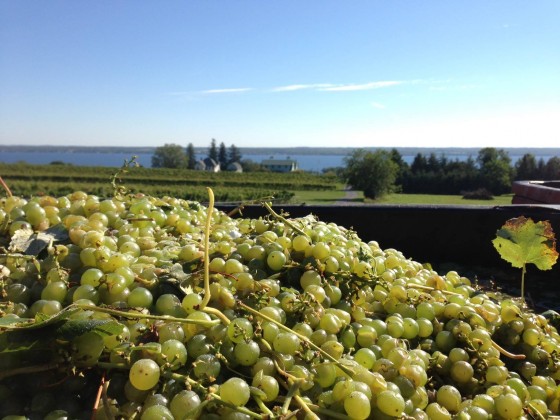
It was the hardest kind of decision to make, and on the morning of September 12, the team at Forge Cellars had to make it. After dozens of hours spent babying his seven-tenths of an acre of pinot noir at Sawmill Creek Vineyard, Rick Rainey knew things had taken a bad turn. An inch of rain on Labor Day had turned up the disease pressure, and sour rot was arriving, day by day, one bunch here, one bunch there. It was going to get worse, despite all of the effort. Forge’s other pinot sites were in better shape, but this vineyard was on the edge.
Louis Barruol, Forge’s co-owner based in Gigondas, France, joined a call via Skype with Rainey and Justin Boyette, co-owner and winemaker. They could pick now, but the entire block would have to become rose. Or they could take their chances, losing fruit by the day.
“We kept coming back to one main idea,” Rainey said. “We kept saying that if you don’t have brilliant fruit, you can’t make brilliant wine. We knew the other vineyards were doing beautifully, but there was no denying what was happening at Sawmill. So we made the call. Pick it now, don’t force it to become mediocre pinot noir. Make a great rose.”
Across the Finger Lakes, such decisions are being made on a daily basis. The 2013 vintage is offering a stern test for growers, and forcing winemakers to place bets on ripening and weather.
Heavy spring rains into June caused some issues, but by late July, the region was on track. A week of low-90s weather in mid-July didn’t scorch the grapes, as temperatures never surged into the upper-90s danger zone. Through early August, the relatively dry weather had vineyards thriving.
Since then, the extreme swings have returned. No rain, then heavy rain. Warm weather, then seasonably cool weather. The early lesson is that wineries can’t afford to take the same approach they took during the spectacular, relatively simple 2012 harvest. Sorting — both in the vineyard and in the winery — will be key to clean fruit and high-quality wines.
Fortunately, the region experienced an even tougher vintage in 2011, and many wineries turned out surprisingly strong wines despite the pressure. That will benefit them this time around.
On September 5, Keuka Spring winemaker August Deimel emailed this ominous warning: “The prerequisites are in place for poor fall weather to lead to a mild disaster.” It was refreshingly honest, but also tempered by this bit of optimism from Deimel: “We started off on the wrong foot weather-wise for the season. That said, growers in the area know what they’re doing. Everyone we talked to is still spraying. Everyone. Everyone recognized that disease pressure would be high and responded. (In 2011) excellent wines were made despite a very difficult growing season. That sort of consistency is indicative of a region turning a corner toward becoming world-class. 2013 will be the year we prove that wasn’t a fluke.”
At Ravines Wine Cellars and White Springs, Morten Hallgren said, “There is significant potential for over-cropping this year. Those vineyards are likely to face difficulties when it comes to ripening. This is not 2012; late-ripening varieties will need all of the hang time they can get. Expect a wide spread in quality and disease pressure.”
Vinny Aliperti, winemaker for Atwater Estate Vineyards and co-owner of Billsboro, explained that he spent the earlier part of September picking for a Blanc de Blanc and a 100% Gewurztraminer Sparkling Cuvee. “If — the big iff — September cooperates, we have a solid vintage,” he said. “Stay tuned.”
During this last week of summer, higher temperatures have finally returned. Last week saw two bizarre days of 93-degree weather, offering a burst for the grapes, but was quickly followed by weather more suited to late October. This week will end with upper-70s and plenty of sunshine, offering either a window for those picking early-ripening varieties, or more pressure-free hangtime.
At Fox Run Vineyards, winemaker Peter Bell noted the relatively constant challenge for vineyard crews. “Mildew was abundant all summer, with a new cycle starting every few days it seemed,” he explained. “There is a lot of latent botrytis as well.” Bell noted that sour rot has been prevalent during his tours around the region, a concern echoed by seemingly every grower who spoke to NYCR.
All of this means that wineries will need more help sorting, but that does not preclude outstanding wine. Working in this region is a challenge, which is a secret to no one in the industry. At Forge Cellars, picking for still pinot noir starts tomorrow at one of their vineyards, while picking at another site won’t happen until next week at the earliest. “That’s the vintage,” Rainey said. “We’re always reevaluating. It can drive you nuts if you want to make truly great wine.”

